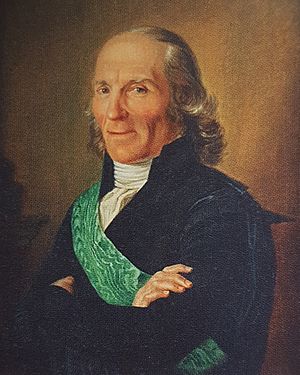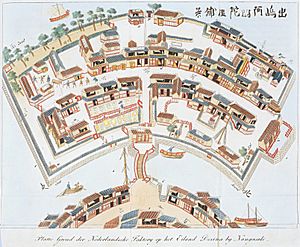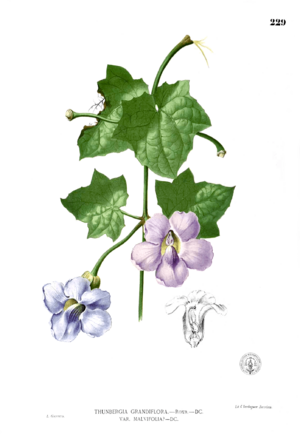Carl Peter Thunberg facts for kids
Quick facts for kids
Carl Peter Thunberg
|
|
|---|---|
 |
|
| Born | 11 November 1743 Jönköping, Sweden
|
| Died | 8 August 1828 (aged 84) Thunaberg, Uppland, Sweden
|
| Nationality | Swedish |
| Other names |
|
| Occupation | Naturalist |
Carl Peter Thunberg (born November 11, 1743 – died August 8, 1828) was a famous Swedish naturalist. He was one of the special students of Carl Linnaeus, who is known as the "father of modern taxonomy".
After studying at Uppsala University, Thunberg spent seven years traveling far away. He visited southern Africa and Asia. During his travels, he collected and described many new plants and animals. These were new to European scientists. He also learned about local cultures. People have called him "the father of South African botany" and the "Japanese Linnaeus".
Contents
Early Life and First Travels
Carl Peter Thunberg was born and grew up in Jönköping, Sweden. When he was 18, he started studying at Uppsala University. There, he was taught by the famous Carl Linnaeus. Thunberg studied for six years and graduated in 1767.
To learn even more about plants, medicine, and nature, Linnaeus encouraged him to travel. In 1770, Thunberg went to Paris and Amsterdam. In Amsterdam and Leiden, he met Dutch scientists Johannes Burman and his son Nicolaas Burman. They were also students of Linnaeus.
The Burmans and another scientist, Laurens Theodorus Gronovius, heard about Thunberg's skills. They convinced him to travel to distant lands. Their goal was to collect new plant and animal samples for the botanic garden in Leiden. Thunberg was excited to visit the Cape of Good Hope in Africa.
To travel to these Dutch-controlled areas, Thunberg joined the Dutch East India Company. He worked as a surgeon on a ship called the Schoonzicht. He started his journey in December 1771. In March 1772, he arrived in Cape Town, which is now in South Africa.
Exploring South Africa
Thunberg stayed in South Africa for three years. He learned to speak Dutch very well. He also studied the culture of the Khoikhoi people. They were the native people of western South Africa. This was the first time he met a non-European culture.
He observed their customs, like greasing their skin. He tried to understand why they did it. He wrote that it protected their skin from heat in summer and cold in winter. This showed his open mind, trying to understand new traditions.
His main goal was to collect plant and animal samples. So, Thunberg often took trips into the wild parts of South Africa. Between September 1772 and January 1773, he traveled with Johan Andreas Auge. They went north of Saldanha Bay and east along the Breede Valley.
Thunberg kept in touch with scientists in Europe. He also met Francis Masson, a Scottish gardener. Masson was collecting plants for the Royal Botanic Gardens, Kew in England. They became friends because of their shared interests. Later, Robert Jacob Gordon joined them on two more trips.
During his three trips, Thunberg collected many plant and animal specimens. While he was in South Africa, he also earned his Doctor of Medicine degree from Uppsala University. On March 2, 1775, Thunberg left the Cape for Batavia (now Jakarta, Indonesia). He arrived there in May and then left for Japan in June.
Adventures in Japan
In August 1775, Thunberg arrived at the Dutch trading post called Dejima. This was a small artificial island in the Bay of Nagasaki, Japan. It was connected to the city by a single bridge. At first, like other Dutch traders, Thunberg was rarely allowed to leave the island.
These rules were set by the Japanese shogun Tokugawa Ieyasu in 1639. This was to stop missionaries from Europe. Only Japanese interpreters and officials could regularly meet with the Dutch.
Soon after arriving, Thunberg became the head surgeon at the trading post. To collect Japanese plants and animals, he found a clever way. He sent small notes with medical tips to the interpreters. In return, they gave him plant knowledge or rare Japanese coins.
Because of this, he was allowed to visit Nagasaki more often. He even got to take one-day trips outside the city. This gave him the chance to collect specimens himself.
During his visits, Thunberg started teaching students. These were mainly the Nagasaki interpreters and local doctors. He taught them about Dutch language and European customs. This helped spread interest in Dutch and European culture, known as rangaku. Thunberg also brought European vegetable seeds. He showed the Japanese new ways to grow plants.
Thunberg also learned a lot from the Japanese. As a former medical student, he was very interested in their medical knowledge. The Japanese taught him about acupuncture. The exchange of ideas led to a new acupuncture point called shakutaku. This discovery combined Thunberg's knowledge of the human body with Japanese traditional medicine. Thunberg also brought back information about Japan's religion and society. This made Europeans more interested in Japan.
His knowledge exchange helped open up both cultures. Universities and schools began teaching about other cultures. Because of this, Thunberg is called "the most important eye witness of Tokugawa Japan in the eighteenth century."
In 1776, Thunberg was allowed to travel with the Dutch ambassador to the shogun's court in Edo (now Tokyo). During this trip, he collected many plants and animals. He also talked to local people along the way. It was during this time that he started writing two important books: Flora Japonica (about Japanese plants) and Fauna Japonica (about Japanese animals).
On his way to Edo, Thunberg also got many Japanese coins. He described them in detail in his travel book. These coins gave European scholars new information about Japan's culture and history. This was important because it was strictly forbidden for foreigners to have or export these coins.
In November 1776, after returning from Edo, Thunberg left Japan. He traveled to Java (now part of Indonesia) and then to Ceylon (now Sri Lanka) in July 1777. Again, he focused on collecting plants and other specimens. In February 1778, Thunberg left Ceylon to return to Europe.
Back in Europe
Thunberg arrived in Amsterdam in October 1778. He made a quick trip to London. There, he met Joseph Banks, a famous botanist. He also saw the Japanese collection of Engelbert Kaempfer, another German naturalist. Kaempfer had visited Japan before him. Thunberg also met Johann Reinhold Forster, who showed him collections from James Cook's second voyage.
When Thunberg arrived back in Sweden in March 1779, he learned that Linnaeus had died a year earlier. Thunberg became a professor of medicine and natural philosophy at Uppsala University in 1781. His many publications and collected specimens helped describe many new species.
He published his Flora Japonica in 1784. In 1788, he started publishing his travel stories. He also wrote Prodromus Plantarum (1800), Icones Plantarum Japonicarum (1805), and Flora Capensis (1813). He was an honorary member of 66 scientific groups. He died near Uppsala on August 8, 1828.
Why He Traveled
During the Age of Enlightenment, it was common for scientists to travel. They would explore new regions and write about their journeys. Thunberg's travels were special because of where he went and how popular his stories became. His travelogue was translated into German, English, and French.
There were three main reasons for his important travels:
- New Information Needed: No new information about Japan had reached Europe for 50 years. Engelbert Kaempfer had visited Japan in 1690. His book from 1729 was famous, but it was old. It was time for new knowledge.
- Scientific Curiosity: The Age of Enlightenment encouraged people to use their minds to discover new things. Many students wanted to leave Europe and learn about less-known places.
- Thunberg's Character: Thunberg was a very curious and smart person. He loved new challenges. So, the journey fit his personal interests perfectly.
Plants Named After Him
A group of tropical climbing plants called Thunbergia is named after him.
Thunberg is also mentioned in the names of about 254 plant and animal species. Here are some famous plants named after him:
- Allium thunbergii
- Amaranthus thunbergii
- Arisaema thunbergii
- Berberis thunbergii
- Fritillaria thunbergii
- Geranium thunbergii
- Lespedeza thunbergii
- Pinus thunbergii
- Spiraea thunbergii
Selected Writings
- Botany
- Flora Japonica (1784)
- Prodromus Plantarum Capensium (1794, 1800)
- Flora Capensis (1807–1823)
- Icones plantarum japonicarum (1805)
- Entomology (Insects)
- Donationis Thunbergianae 1785 continuatio I. Museum naturalium Academiae Upsaliensis, pars III (1787)
- Dissertatio Entomologica Novas Insectorum species sistens (1789)
- D. D. Dissertatio entomologica sistens Insecta Suecica (1794)
See also
 In Spanish: Carl Peter Thunberg para niños
In Spanish: Carl Peter Thunberg para niños



